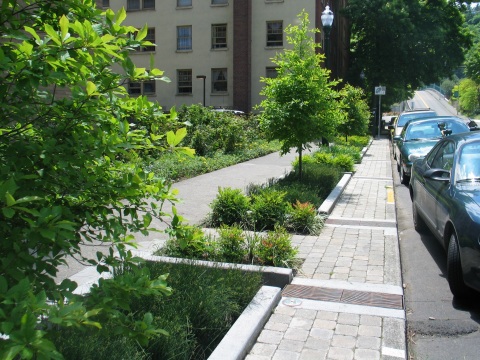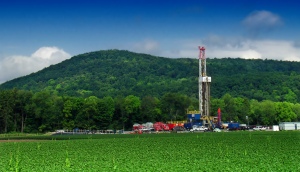Category Archives: land management
What lessons are to be learned from stakeholder engagement in transportation planning when broad efforts to engage fall short of actual public consultation?
In “Whose Opinion Matters: Lessons from a Stakeholder Engagement Process for Penang, Malaysia” Dr. Minal Pathak conducted an evaluation of the ongoing stakeholder engagement process for the transport master plan in Penang, Malaysia. Proposed funding for the plan’s estimated 11 billion USD cost – involving highways, roadways, LRT, monorail, a BRT network, and electric trams – was through reclamation of three islands along the Penang coast. Concerns about the plan raised by stakeholders range from high costs, environmental impacts, effects on fisheries, and aesthetic and heritage considerations. Key issues with timing, strategy and communication in the engagement process have contributed to various stakeholders’ continued opposition to the project. Dr. Pathak’s evaluation draws out recommendations for a more effective stakeholder engagement process that can be applied both within Malaysia and beyond.
Civic spaces and brownfield redevelopment, a case study of the Social Innovation project in Somerville, MA
 Former brownfield sites offer opportunities for economic growth. How can industrial cities dealing with legacy of contained areas promote neighborhood-scale arts-oriented development? Can such sites benefit from policy integration? MCP Allegra Fonda-Bonardi did a yearlong study of the ARTFarm for Social Innovation in Somerville; Massachusetts to better understand how one city tried to find the right balance between environmental clean-up, real estate reinvestment and neighborhood control of the development process. She starts of with the premise that integrating city-wide environmental, social, and economic sustainability is possible, and that civic spaces that aim to meet multiple objectives are more likely to succeed than those that don’t. Allegra also discusses in her thesis the importance of demanding accountability from developers who offer to fund remediation, to ensure that a portion of the remediated land is used to meet neighborhood priorities. Did the ArtFarm create a precedent? You can find the answer to this question and more in Allegra’s thesis, here.
Former brownfield sites offer opportunities for economic growth. How can industrial cities dealing with legacy of contained areas promote neighborhood-scale arts-oriented development? Can such sites benefit from policy integration? MCP Allegra Fonda-Bonardi did a yearlong study of the ARTFarm for Social Innovation in Somerville; Massachusetts to better understand how one city tried to find the right balance between environmental clean-up, real estate reinvestment and neighborhood control of the development process. She starts of with the premise that integrating city-wide environmental, social, and economic sustainability is possible, and that civic spaces that aim to meet multiple objectives are more likely to succeed than those that don’t. Allegra also discusses in her thesis the importance of demanding accountability from developers who offer to fund remediation, to ensure that a portion of the remediated land is used to meet neighborhood priorities. Did the ArtFarm create a precedent? You can find the answer to this question and more in Allegra’s thesis, here.
Urban Agriculture Contributes to Sustainable Development of Cities: How do we make it permanent?

In the 21st century cities have increasingly adopted sustainability as a guiding principal, offering a window of opportunity for the incorporation of urban agriculture into city land use planning efforts. In addition, the engagement of commercial urban farms with local economies has allowed urban agriculture to enter the realm of economic development. Despite these advancements, many still frame their understanding of urban agriculture as interim land use while waiting for appropriate real estate development to happen. In his 2014 thesis, Andrew Cook (MCP ’14) argues the sustainable development characteristics of urban agriculture can only be accessed by treating it as permanent rather than a temporary land use.
To illustrate his argument, Andrew draws on a case study of Baltimore City, specifically the temporary use on city-owned land programs: Adopt-A-Lot and Homegrown Baltimore Land Lease Initiative. Andrew traced the historical relationship of urban agriculture to city development, Baltimore’s shrinking population, Baltimore’s policy environment as well as the histories of each program. He found that Baltimore’s view that urban agriculture runs counter to the economic growth objectives of a city, has limited the sustainability, economic, environmental and social benefits of urban agriculture projects. Through his evaluation of several urban commercial farms, community farms and demonstration farms, Andrew provides an alternate view, showing how urban agriculture can drive rather than hindering economic development. He offers a series of recommendations that woucl allow cities to realize the maximum benefit of urban agriculture. To learn more, read Andrew’s full thesis here.
How can we do a better job of promoting investment in green infrastructure?
A Methodology for Greater Impact of Green Infrastructure Projects
The planning community has increasingly recognized green infrastructure as the most effective approach for cities to manage the environmental impacts of stormwater runoff, a major sources of contamination to urban waterways. Despite this recognition, green infrastructure has not yet achieved the desired scale of implementation, in part, because implementation produces highly variable results. However, green infrastructure pilot studies, called ‘demonstration projects,’ have been conducted throughout the United States with encouraging results.
In his thesis, Alex Marks (MCP ’15), uses the case of Boston to explore how demonstration projects can further green infrastructure implementation. Alex identifies four major objectives of case studies: (1) testing the physical performance of green infrastructure for wider use, (2) fostering interdepartmental learning to construct and maintain green infrastructure projects, (3) cultivating public awareness and support for green infrastructure, and (4) achieving regulatory compliance. If demonstration projects are designed to reflect these four objectives, they can reduce the hazards of stormwater runoff. Alex constructs a recommended demonstration project methodology to assist city planners in formulating green infrastructure initiatives. Green infrastructure can contribute to greater equity in the allocation of stormwater discharge permits. To read more, see Alex’s thesis, here.
How Can We Limit or Mitigate Contention Over Solar Power Infrastructure Development
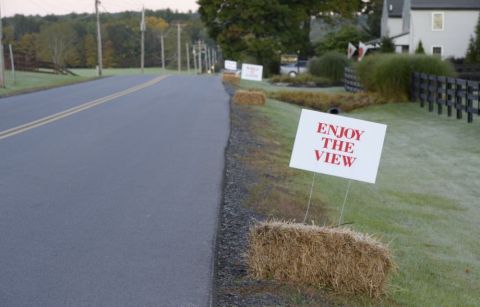 Human reliance on fossil fuels has led to a wide range of adverse environmental and health effects. As our understanding of these impacts has grown, so has the search for other, more sustainable sources of energy. One such source is solar power. The federal and state governments of the United States have created various policies and financial incentives to encourage adoption of solar energy technologies.
Human reliance on fossil fuels has led to a wide range of adverse environmental and health effects. As our understanding of these impacts has grown, so has the search for other, more sustainable sources of energy. One such source is solar power. The federal and state governments of the United States have created various policies and financial incentives to encourage adoption of solar energy technologies.
While solar energy offers tremendous potential benefits, siting utility-scale ground-mounted photovoltaic arrays can give rise to strong public reaction. In her 2014 thesis, Siting solar energy facilities in New York state: sources of and responses to controversy, Casey Stein (MCP 2014) examines the controversy, or lack thereof, surrounding the siting of utility-scale solar energy facilities in New York by exploring two case studies – the Skidmore College Denton Road solar array and the Cornell University Snyder Road solar array.
Despite the large number of commonalities between these two solar energy facilities, the Skidmore College array created a much greater level of controversy than the Cornell University array. Analysis of this divergence indicates that choice of the physical site is a crucial determinant of the extent of controversy. While local impacts are an important concern, Casey demonstrates the reasons for controversy go well beyond those tangible impacts. Issues related to information, equity, and trust played roles as key sources of controversy. By comparing and contrasting the controversy surrounding these two solar energy arrays, Casey is able to offer recommendations to limit or mitigate contention around future solar power infrastructure development.
To read Casey’s thesis, click here.
Building Stability Through Decentralization
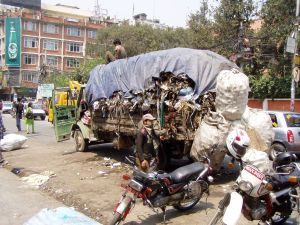 As India continues to industrialize and urbanize, levels of consumption and waste continue to grow, placing stress on waste management systems.
As India continues to industrialize and urbanize, levels of consumption and waste continue to grow, placing stress on waste management systems.
Traditionally, Indian cities relied upon a combination of a formal municipal collection and processing; informal recycling, collection and processing; and waste pickers. However, urban sprawl and a lack of sites for new landfills have outpaced the capacity of traditional systems. The response has been to turn to private enterprise to manage waste, but this approach comes with severe draw backs in terms of social and environmental justice.
India’s waste pickers are vulnerable to changes in solid waste management policies. A shift towards more formal privatized systems, leaves little room for this large labor force. Privatized waste management also hinges on maximizing profits at scale, thus leading to greater reliance on landfills. This disproportionately effects the most vulnerable groups in cities, since they do not have the political power to resist the siting of new landfills.
In her 2014 thesis, Caroline Howe argues for Indian cities to build the capacity of the informal waste management sector and to invest in decentralized waste processing. By investing in these ways, Caroline finds, Indian cities would develop a more sociall- just, economical, and environmentally friendly waste management system. In addition, by protecting a large population of workers in India, cities would be more resilient to economic and social challenges.
No Idling: Parking Policy in Growing Cities
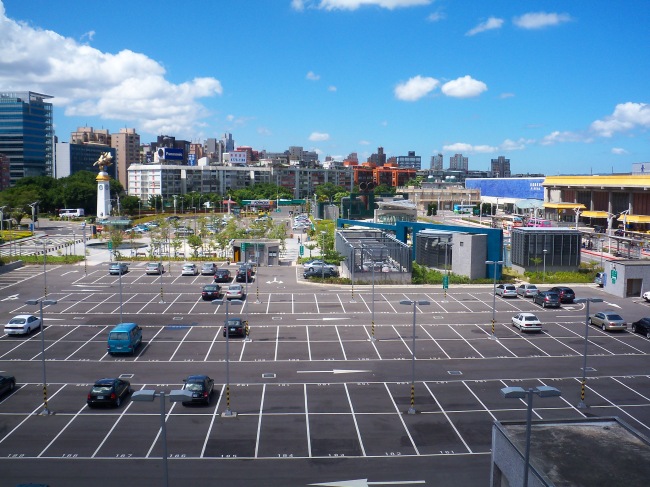 There are few urban issues that touch as many nerves as parking, which resides in the often uncomfortable overlap of transportation, environmental protection, land use, and economic growth. To determine how much parking cities should have—and where that parking should be—a wide variety of stakeholder need to interact in a complex political process. Debates over parking policy, it turns out, are rarely just about parking.
There are few urban issues that touch as many nerves as parking, which resides in the often uncomfortable overlap of transportation, environmental protection, land use, and economic growth. To determine how much parking cities should have—and where that parking should be—a wide variety of stakeholder need to interact in a complex political process. Debates over parking policy, it turns out, are rarely just about parking.
In her thesis, Cara Ferrentino (MCP ’13) took a close look at the formation of parking policy in Cambridge, Massachusetts. She shows how three distinct groups—the “growth coalition”, “limited growth” advocates, and “smart growth” bureaucrats—have nudged the city into adopting and reforming policies regarding parking supply.
Cambridge was forced to confront parking in the 1970s, when EPA regulations enforced a mandatory parking freeze on the city’s non-residential parking supply to ensure compliance with the Clean Air Act. But, driven by concerns over the freeze’s impact on Cambridge’s commercial growth, the city lifted the freeze in 1997 and adopted instead a variety of demand-side approaches to managing parking supply. Today, Cambridge uses a number of incentives to encourage the use of alternative modes of transportation. These are often implemented in cooperation with the city’s major employers.
Cara evaluates the success of these efforts and finds that, while many employers have taken steps to encourage alternative transportation, the city nonetheless builds more non-residential parking than it uses. She notes that the city will need to rethink both the supply side and the demand side of parking policy in the near future if it is going to provide just the right amount of parking in all the right places. Read more about the past, present, and future of parking policy in Cambridge in Cara’s thesis.
How Small Towns Think About Big Gas
Thanks to technological advances in natural gas exploration, many rural American towns are now confronted by a puzzle with which they have little experience: how to regulate gas drilling in their backyards. The reactions of local jurisdictions to natural gas have varied widely, as officials have considered the tradeoff between economic rewards and environmental risks. What explains the disparity in the approaches that local governments take to gas drilling? How do they decide about local policy?
Jessie Agatstein (MCP ’13) takes on this question in her thesis, which looks at local responses to natural gas drilling in three communities—Erie, CO, Washington County, ID, and Dryden, NY—all with populations under 20,000. These localities have adopted markedly different approaches to natural gas exploration. Erie has pursued negotiated agreements with specific developers, Washington County has utilized special use provisions to define where and how drilling may occur, and Dryden has banned the practice all together.
Much of this difference, Jessie notes, can be explained by two things. The first is the delegation of regulatory authority over natural gas exploration in many states to local governments, producing a wide array of policy approaches across countless jurisdictions. The second is what Jessie terms “problem diffusion.” It results from differences in how gas issues are viewed on the ground in different geographic contexts. Instead of copying the policies that other nearby jurisdictions have taken, local officials respond mostly to the problems that their neighbors have encountered and formulate policies that are intended to counteract these difficulties.
Jessie also notes the high level of sophistication with which local officials in the communities she studied with have approached natural gas exploration. Contradicting the stereotype of outmatched and incapable small town governments, officials have deftly navigated many complex issues. In some cases they have charted new policy territory. She cites the wealth of public information available online about natural gas impacts and local regulatory policy as strong contributors to the effectiveness of local officials in dealing with natural gas.
What insights can you share about how communities have reacted to natural gas exploration? Post a comment below, or read more in Jessie’s thesis.
The Problem with Short-Term Thinking: Miami-Dade County’s Experience with Land-Use Management

In 1993, Miami-Dade County was one of the first jurisdictions in the nation to adopt a plan for climate change. A crucial leg of this plan
was to reduce vehicles miles traveled (VMT) through comprehensive land use management and improved mass transit. Evaluating the plan 15 years later, Haley Peckett (MCP 2009) found that a poorly structured system of political incentives had instead led to a substantial increase in VMT, and set out to examine the root causes of this failure.
Haley attributes much of the blame for poor land-use management with the Miami-Dade Board of County Commissioners, a group torn across racial and ethnic lines and accountable only to their individual districts and constituencies. Following through on the county’s ambitious land use management plan would require commissioners to “hold the line” against voters and advocate groups unhappy with some negative effects of land use management and transit expansion, such as tax increases and limited availability of developable land for affordable housing.
However, with nobody in the decision-making process empowered to adopt a comprehensive perspective on what is best for the county as a whole, Haley describes how commissioners have time and again compromised the county’s long-term vision for smart growth in the sake of short-term political wins for their constituents. If Miami-Dade is to successfully implement a land-use management plan, she notes, it will have to adopt a longer view on policy outcomes and allow an independent entity with a broader view on the effects of land use to play a serious role in the policy formation process.
Read more about the battle over land use policy in Miami-Dade County in Haley’s thesis.
Protecting the Florida Orange from Urban Expansion
Fortunately, Florida saw this problem coming and in 1985 passed a Growth Management Act that required cities and towns to undertake comprehensive land use planning efforts. The resulting plans reserved certain areas for open space and agriculture. But is preparing a plan enough to stop the inexorable expansion of cities? Stephen Lloyd (MCP ’11) aimed to find out.
